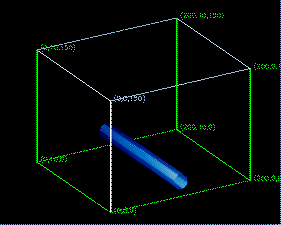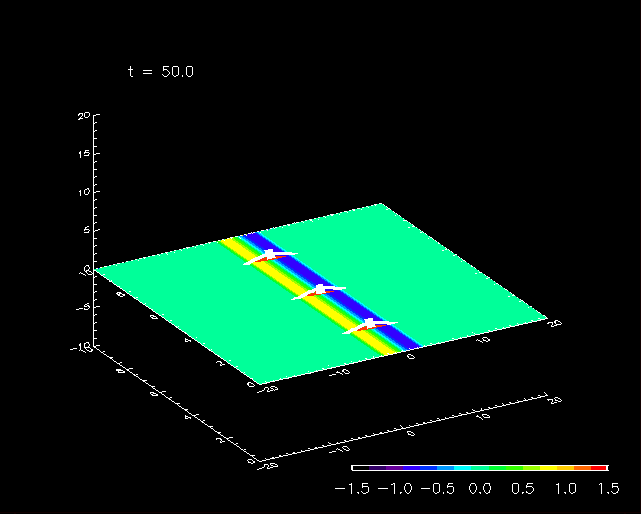

We have simulated the emergence of a twisted flux tube into the corona using a three-dimensional, time-dependent code. After emergence, the outer, azimuthal field of the tube expands to naturally form potential-like arcade structure, while the inner, axial field that emerges after the tube axis produces a twisted sigmoidal structure. The low-lying, inner field lines originate from regions of the highest current concentration and therefore will be the most visible in coronal emission such as soft X-rays (Magara & Longcope 2001).
Magara, T. & Longcope, D. W. 2001 ApJL, in press

Recently I study the expansion process of emerging flux tubes in the solar atmosphere (Figure 6). The aim of this study is to investigate the physical mechanism of those solar phenomena related to emerging flux tubes, such as tiny bipoles, arch filament systems, sunspots, filaments, X-ray brightenings, coronal mass ejections, and the sigmoid strucuture of coronal arcades. The following two animations are based on a 2.5-dimensional MHD simulation (Magara 2001).
Magara, T. 2001 ApJ, 549, 608

|

|
Evolution of an emerging flux tube |
Emergence of magnetic field lines |

We present an explanation of the shock formation related to coronal and interplanetary type II radio bursts associated with coronal mass ejections (CMEs) on the basis of the CSHKP model. Coronal type II bursts are usually observed in metric wavelength range (metric type II bursts) and interplanetary bursts are observed in decametric-hectometric wavelength range (decametric-hectometric bursts). Our research shows that decametric-hectometric type II radio bursts are produced by the piston-driven fast-mode MHD shock which is formed in front of an eruptive plasmoid (a magnetic island in the 2-dimensional sense or a magnetic flux rope in the 3-dimensional sense), while the metric radio bursts are produced by the reverse fast-mode MHD shock which is formed through the collision of strong reconnection jet to the bottom of the plasmoid (Figure 5). This reverse shock moves apparently upward as long as the reconnection jet is sufficiently strong, and dies away when the energy releases by the reconnection stops or weakens significantly. On the other hand, the piston-driven fast-mode MHD shock continues to travel outward.
Magara, T., Chen, P. F., Shibata, K., & Yokoyama, T. 2000 ApJ, 538, L175
Reiner, M. J., Kaiser, M. L., Plunkett, S. P., Prestage, N. P., & Manning, R. 2000, ApJ, 529, L53

While studying the problem on energy releases in solar flares, I am also interested in energy accumulation processes in these explosive phenomena. Since we can often observe explosive events associated with filaments, the study of filament activities could tell us how the energy for explosion is accumulated and stored. This is why we investigated gas motions around a filament. (The side reason is that I had a nice chance to touch a lot of useful data of filaments since I got a job at Hida observatory!) We think that patterns of gas motions are a key factor to know energy accumulation processes so that we derived several photospheric velocity fields by means of Local Correlation Technique (LCT) from G-band image data (Figure 4). We found shearing or converging motions arouond a filament. These motions probably have a close relationship to energy build-up processes in a magnetic arcade overlying the filament (Magara & Kitai 1999).
Magara, T., & Kitai, R. 1999, ApJ, 524, 469

In those works presented above ("Loop top source of solar flares" and "Plasmoid dynamics") we focus our attention on the explosive phase of flares in which a huge amount of energy is released quickly in various forms. On the basis of the reconnection model of solar flares, such a violent energy release can be caused by fast magnetic reconnection. It is therefore important to find out how the fast magnetic reconnection occurs in the evolution of solar flares, which is the aim of our study on the preflare phase (Magara & Shibata 1999). Since it has been suggested that a spatially localized resistivity is needed for fast magnetic reconnection, we investigated how the distribution of resistivity changes from a uniform distribution to a localized one inside current sheet at the preflare phase. We started with a current sheet under a uniform resistivity, which is later subject to the tearing instability. By simulating this process, we found that the current sheet was strongly compressed locally around X-points which were formed by the tearing process. We derived a scaling law about the thickness of compressed area in order to see how thin the compressed area becomes in the environment of the solar corona. Consequently, we obtained the result that the current sheet is compressed strongly enough to generate an anomalously enhanced resistivity in the corona (Figure 3). This means that coronal current sheets naturally become the candidate to cause energetic explosions.
Magara, T., & Shibata, K. 1999, ApJ, 514, 456
My doctor thesis entitled "A Study of Solar Flares Based on Comparison between Theory and Observation" mainly consists of those works introduced in "Loop top source of solar flares" and "Plasmoid dynamics". The following is the contents of thesis.
Magara, T. 1998, Ph. D. Thesis, Univ. Kyoto

From a viewpoint of the
CSHKP model,
upward reconnection jets are expected to
arise at the onset of flares, which often make a significant contribution
to the ejection of plasmoids.
We performed MHD numerical simulations to study this highly dynamical process.
Observationally,
it is known that an eruptive plasmoid has three evolutionary phases; that is,
the initial gradual rise, the short-term
abrupt acceleration, and the long-lasting steady rise
(Ohyama & Shibata 1997). By comparing simulation
results with these observable features, we clarified the physical processes
in those three phases
(Figure 2). According to our results, a plasmoid
starts rising slowly when a weak resistive process arises
inside the underlying current sheet, then it is accelerated strongly
once a fast magnetic reconnection occurs in the current sheet, and it finally
rises at constant speed after a reverse
fast-mode MHD shock is well developed at the bottom of
the plasmoid (Magara, Shibata, & Yokoyama 1997).
Magara, T., Shibata, K., & Yokoyama, T. 1997, ApJ, 487, 437
Ohyama, M., & Shibata, K. 1997, PASJ, 49, 249

This work is based on a new observational result found by Yohkoh, that a hard X-ray source appears over soft X-ray flaring loops in compact flares (Masuda et al. 1994; left panel in Figure 1). In order to explain the formation process of this loop-top source, we investigated dynamical aspects of the so-called CSHKP model, a famous solar flare model based on magnetic reconnection, by performing 2-dimensional MHD numerical simulations. The result is that a plasma jet originating from a reconnection point collides with the underlying closed loop to form a fast-mode MHD shock, behind which a hot and dense core appears (Magara et al. 1996; right panel in Figure 1). The temperature of this core is consistent with the value derived from hard X-ray data (about hundred million degrees) if the thermal radiation is assumed (Magara 1998). We also proposed that the difference in appearance between short-lived flares (impulsive flares) and long-duration flares (LDE flares) is due to the efficiency of the magnetic reconnection working in individual flares (Magara et al. 1996).
Magara, T., Mineshige, S., Yokoyama, T., & Shibata, K. 1996, ApJ, 466, 1054
Magara, T. 1998, Ph. D. Thesis, Univ. Kyoto
Masuda, S., Kosugi, T., Hara, H., Tsuneta, S., & Ogawara, Y. 1994, Nature, 371, 495